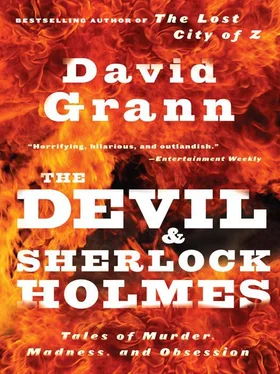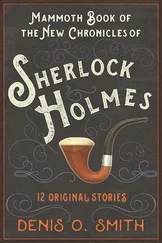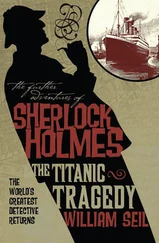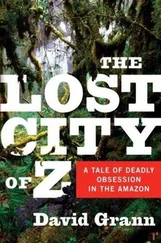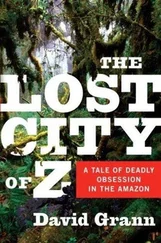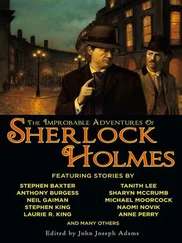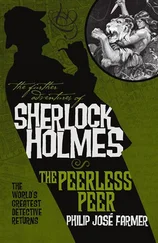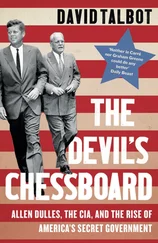David Grann - The Devil & Sherlock Holmes
Здесь есть возможность читать онлайн «David Grann - The Devil & Sherlock Holmes» весь текст электронной книги совершенно бесплатно (целиком полную версию без сокращений). В некоторых случаях можно слушать аудио, скачать через торрент в формате fb2 и присутствует краткое содержание. Жанр: Старинная литература, на английском языке. Описание произведения, (предисловие) а так же отзывы посетителей доступны на портале библиотеки ЛибКат.
- Название:The Devil & Sherlock Holmes
- Автор:
- Жанр:
- Год:неизвестен
- ISBN:нет данных
- Рейтинг книги:3 / 5. Голосов: 1
-
Избранное:Добавить в избранное
- Отзывы:
-
Ваша оценка:
- 60
- 1
- 2
- 3
- 4
- 5
The Devil & Sherlock Holmes: краткое содержание, описание и аннотация
Предлагаем к чтению аннотацию, описание, краткое содержание или предисловие (зависит от того, что написал сам автор книги «The Devil & Sherlock Holmes»). Если вы не нашли необходимую информацию о книге — напишите в комментариях, мы постараемся отыскать её.
comes this brilliant collection of true stories about people whose fixations propel them into unfathomable and often deadly circumstances.
Whether David Grann is investigating a mysterious murder, tracking a chameleon-like con artist, or hunting an elusive giant squid, he has proven to be one of the most gifted reporters and storytellers of his generation. In
, Grann takes the reader around the world, revealing a gallery of rogues and heroes who show that truth is indeed stranger than fiction.
The Devil & Sherlock Holmes — читать онлайн бесплатно полную книгу (весь текст) целиком
Ниже представлен текст книги, разбитый по страницам. Система сохранения места последней прочитанной страницы, позволяет с удобством читать онлайн бесплатно книгу «The Devil & Sherlock Holmes», без необходимости каждый раз заново искать на чём Вы остановились. Поставьте закладку, и сможете в любой момент перейти на страницу, на которой закончили чтение.
Интервал:
Закладка:
After Green graduated from Oxford, in 1975, he turned his attention to more serious scholarship. Of all the puzzles surrounding the Sacred Writings, the greatest one, Green realized, centered on the man whom the stories had long since eclipsed—Conan Doyle himself. Green set out to compile the first comprehensive bibliography, hunting down every piece of material that Conan Doyle wrote: pamphlets, plays, poems, obituaries, songs, unpublished manuscripts, letters to the editor. Carrying a plastic bag in place of a briefcase, Green unearthed documents that had long been hidden behind the veil of history.
In the midst of this research, Green discovered that John Gibson was working on a similar project, and they agreed to collaborate. The resulting tome, published in 1983 by Oxford University Press, with a foreword by Graham Greene, is seven hundred and twelve pages long and contains notations on nearly every scrap of writing that Conan Doyle ever produced, down to the kind of paper in which a manuscript was bound (“cloth,” “light blue diaper-grain”). When the bibliography was done, Gibson continued in his job as a government property assessor. Green, however, had inherited a sizable sum of money from his family, who had sold part of their estate, and he used the bibliography as a launching pad for a biography of Conan Doyle.
Writing a biography is akin to the process of detection, and Green started to retrace every step of Conan Doyle’s life, as if it were an elaborate crime scene. During the nineteen-eighties, Green followed Conan Doyle’s movements from the moment he was born, on May 22, 1859, in a squalid part of Edinburgh. Green visited the neighborhood where Conan Doyle was raised, by a devout Christian mother and a dreamy father. (He drew one of the first illustrations of Sherlock Holmes—a sketch of the detective discovering a corpse, which accompanied a paperback edition of “A Study in Scarlet.”) Green also amassed an intricate paper record that showed his subject’s intellectual evolution. He discovered, for instance, that after Conan Doyle studied medicine, at the University of Edinburgh, and fell under the influence of rationalist thinkers like Oliver Wendell Holmes—who undoubtedly inspired the surname of Conan Doyle’s detective—he renounced Catholicism, vowing, “Never will I accept anything which cannot be proved to me.”
In the early eighties, Green published the first of a series of introductions to Penguin Classics editions of Conan Doyle’s previously uncollected works—many of which he had helped to uncover. The essays, written in a clinical style, began garnering him attention outside the insular subculture of Sherlockians. One essay, running to more than a hundred pages, was a small biography of Conan Doyle unto itself; in another, Green cast further light on the short story “The Case of the Man Who Was Wanted,” which had been found in a chest more than a decade after Conan Doyle’s death and was claimed by his widow and sons to be the last unpublished Holmes story. Some experts had wondered if the story was a fake and even if Conan Doyle’s two sons, in search of money to sustain their lavish lifestyles, had forged it. Yet Green conclusively showed that the story was neither by Conan Doyle nor a forgery; instead, it was written by an architect named Arthur Whitaker, who had sent it to Conan Doyle in hopes of collaborating. Scholars described Green’s essays variously as “dazzling,” “unparalleled,” and—the ultimate compliment—“Holmesian.”
Still, Green was determined to dig deeper for his now highly anticipated biography. As the mystery writer Iain Pears has observed, Conan Doyle’s hero acts in nearly the same fashion as a Freudian analyst, piecing together his clients’ hidden narratives, which he alone can perceive. In a 1987 review of Conan Doyle’s autobiography, “Memories and Adventures,” which was published in 1924, Green noted, “It is as if Conan Doyle—whose character suggested kindliness and trust—had a fear of intimacy. When he describes his life, he omits the inner man.”
To reveal this “inner man,” Green examined facts that Conan Doyle rarely, if ever, spoke of himself—most notably, that his father, an epileptic and an incorrigible alcoholic, was eventually confined to an insane asylum. Yet the more Green tried to plumb his subject, the more he became aware of the holes in his knowledge of Conan Doyle. He didn’t want just to sketch Conan Doyle’s story with a series of anecdotes; he wanted to know everything about him. In the draft of an early mystery story, “The Surgeon of Gaster Fall,” Conan Doyle writes of a son who has locked his raving father inside a cage—but this incident was excised from the published version. Had Conan Doyle been the one to commit his father to the asylum? Was Holmes’s mania for logic a reaction to his father’s genuine mania? And what did Conan Doyle mean when he wrote, in his deeply personal poem “The Inner Room,” that he “has thoughts he dare not say”?
Green wanted to create an immaculate biography, one in which each fact led inexorably to the next. He wanted to be both Watson and Holmes to Conan Doyle, to be his narrator and his detective. Yet he knew the words of Holmes: “Data! Data! Data! I can’t make bricks without clay.” And the only way to succeed, he realized, was to track down the lost archive.
“Murder,” Owen Dudley Edwards, a highly regarded Conan Doyle scholar, said. “I fear that is what the preponderance of the evidence points to.”
I had called him in Scotland, after Gibson informed me that Edwards was pursuing an informal investigation into Green’s death. Edwards had worked with Green to stop the auction, which took place, in spite of the uproar, almost two months after Green’s body was found. Edwards said of his friend, “I think he knew too much about the archive.”
A few days later, I flew to Edinburgh, where Edwards promised to share with me his findings. We had arranged to meet at a hotel on the edge of the old city. It was on a hill studded with medieval castles and covered in a thin mist, not far from where Conan Doyle had studied medicine under Dr. Joseph Bell, one of the models for Sherlock Holmes. (Once, during a class, Bell held up a glass vial. “This, gentlemen, contains a most potent drug,” he said. “It is extremely bitter to the taste.” To the class’s astonishment, he touched the amber liquid, lifted a finger to his mouth, and licked it. He then declared, “Not one of you has developed his power of perception … while I placed my index finger in the awful brew, it was my middle finger—aye—which somehow found its way into my mouth.”)
Edwards greeted me in the hotel lobby. He is a short, pear-shaped man with wild gray sideburns and an even wilder gray beard. A history professor at the University of Edinburgh, he wore a rumpled tweed coat over a V-neck sweater, and carried a knapsack on his shoulder.
We sat down at the restaurant, and I waited as he rummaged through the books in his bag. Edwards, who has written numerous books, including “The Quest for Sherlock Holmes,” an acclaimed account of Conan Doyle’s early life, began pulling out copies of Green’s edited collections. Green, he said, was “the world’s greatest Conan Doyle expert. I have the authority to say it. Richard ultimately became the greatest of us all. That is a firm and definite statement of someone who knows.”
As he spoke, he tended to pull his chin in toward his chest, so that his beard fanned out. He told me that he had met Green in 1981, while researching his book on Conan Doyle. At the time, Green was still working on his bibliography with Gibson; even so, he had shared all his data with Edwards. “That was the kind of scholar he was,” he said.
To Edwards, Green’s death was even more baffling than the crimes in a Holmes story. He picked up one of the Conan Doyle collections and read aloud from “A Case of Identity,” in the cool, ironical voice of Holmes:Life is infinitely stranger than anything which the mind of man could invent. We would not dare to conceive the things which are really mere commonplaces of existence. If we could fly out of that window hand in hand, hover over this great city, gently remove the roofs, and peep in at the queer things which are going on, the strange coincidences, the plannings, the cross-purposes, the wonderful chains of events, working through generations, and leading to the most outré results, it would make all fiction with its conventionalities and foreseen conclusions most stale and unprofitable.
Читать дальшеИнтервал:
Закладка:
Похожие книги на «The Devil & Sherlock Holmes»
Представляем Вашему вниманию похожие книги на «The Devil & Sherlock Holmes» списком для выбора. Мы отобрали схожую по названию и смыслу литературу в надежде предоставить читателям больше вариантов отыскать новые, интересные, ещё непрочитанные произведения.
Обсуждение, отзывы о книге «The Devil & Sherlock Holmes» и просто собственные мнения читателей. Оставьте ваши комментарии, напишите, что Вы думаете о произведении, его смысле или главных героях. Укажите что конкретно понравилось, а что нет, и почему Вы так считаете.
